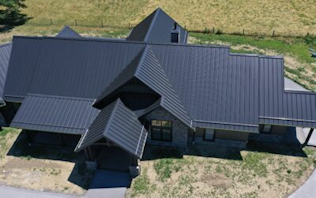Metal Coils & Sheets for Metal Roofing & Wall Systems
Coil & Sheet Products | COOLR® Metal Roofing
Sheffield Metals is a leading distributor of coated and bare metal coils and sheets to the architectural metal roofing market. Our metal products are produced from full-prime Galvalume®, acrylic-coated Galvalume®, and aluminum purchased from U.S. domestic mills. We’re always striving to provide the best customer service in the industry, which is why we proudly ship most orders within three days from one of our strategically located manufacturing facilities that have full-slitting and cut-to-length abilities across the country.
COOLR® is a family of sustainable, energy-efficient roofing products that meet LEED V4.1 compliance in many of the paint finishes. COOLR products come in a wide variety of colors, gauges, widths, and substrates for low and steep slope applications.
We stock over 50 colors that are painted with Sherwin Williams’s Fluropon, a high-performance Kynar 500® / Hylar 5000® PVDF resin-based coating that allows us to meet most ASTM physical property performance requirements. We also offer custom color matching to accommodate any architect, property owner, or corporate color palette with their design.
COOLR® Metal Roofing
Coolr 24 Guage Metal Roofing Material
Throughout the industry, 24-gauge Galvalume is usually the standard thickness for standing seam metal roof and wall systems. Standing seam refers to a concealed fastener metal panel system with vertical legs and a broad, flat area between the two legs. Standing seam systems have hidden fasteners, whether the panel is attached to the roof deck using a clip or is directly fastened to the deck under the vertical leg utilizing a fastener flange.
Coolr 26 Guage Metal Roofing Material
26-gauge, is usually considered the standard metal thickness for exposed fastener metal roofing. Exposed fastener metal roofing is a roofing system where the panels are fastened to the structure through the face of the metal and directly into the roof deck or framing below. The panel edges lap one another, and the fastener goes through both layers of metal. It’s called an “exposed fastener” because the head of the fastener is visible and not hidden by a seam.



